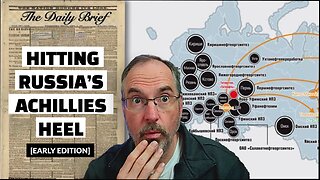Premium Only Content

The seabed (also known as the seafloor, sea floor, ocean floor, and ocean bottom) is the bottom of the ocean. All floors of the ocean are known as 'seabeds'.
The structure of the seabed of the global ocean is governed by plate tectonics. Most of the ocean is very deep, where the seabed is known as the abyssal plain. Seafloor spreading creates mid-ocean ridges along the center line of major ocean basins, where the seabed is slightly shallower than the surrounding abyssal plain. From the abyssal plain, the seabed slopes upward toward the continents and becomes, in order from deep to shallow, the continental rise, slope, and shelf. The depth within the seabed itself, such as the depth down through a sediment core, is known as the “depth below seafloor.” The ecological environment of the seabed and the deepest waters are collectively known, as a habitat for creatures, as the “benthos.”
Most of the seabed throughout the world's oceans is covered in layers of marine sediments. Categorized by where the materials come from or composition, these sediments are classified as either: from land (terrigenous), from biological organisms (biogenous), from chemical reactions (hydrogenous), and from space (cosmogenous). Categorized by size, these sediments range from very small particles called clays and silts, known as mud, to larger particles from sand to boulders.
Features of the seabed are governed by the physics of sediment transport and by the biology of the creatures living in the seabed and in the ocean waters above. Physically, seabed sediments often come from the erosion of material on land and from other rarer sources, such as volcanic ash. Sea currents transport sediments, especially in shallow waters where tidal energy and wave energy cause resuspension of seabed sediments. Biologically, microorganisms living within the seabed sediments change seabed chemistry. Marine organisms create sediments, both within the seabed and in the water above. For example, phytoplankton with silicate or calcium carbonate shells grow in abundance in the upper ocean, and when they die, their shells sink to the seafloor to become seabed sediments.
Human impacts on the seabed are diverse. Examples of human effects on the seabed include exploration, plastic pollution, and exploitation by mining and dredging operations. To map the seabed, ships use acoustic technology to map water depths throughout the world. Submersible vehicles help researchers study unique seabed ecosystems such as hydrothermal vents. Plastic pollution is a global phenomenon, and because the ocean is the ultimate destination for global waterways, much of the world's plastic ends up in the ocean and some sinks to the seabed. Exploitation of the seabed involves extracting valuable minerals from sulfide deposits via deep sea mining, as well as dredging sand from shallow environments for construction and beach nourishment.
-
 27:23
27:23
Clickbait Wasteland
14 hours agoAsking New Yorkers Who They Support For Mayor: Staten Island
1.17K1 -
 16:58
16:58
World2Briggs
22 hours agoThe California Rant: Point Blank With No Fluff or BS. California Gold?
929 -
 17:49
17:49
Chris Harden
1 day ago $0.01 earnedThe Glass Capital That Shattered | The Decline of Streator, Illinois
920 -
 51:15
51:15
JohnXSantos
3 days agoClothing Brand Manufacturers + Winners
6351 -
 10:06
10:06
Cyclops Videos Joe W Rhea
12 days agoHybrid Super 22 Rifle
1.34K -
 8:30
8:30
Millionaire Mentor
20 hours agoMaria Bartiromo Plays Clip That DESTROYS Adam Schiff’s Entire Story
810 -
 27:32
27:32
The Finance Hub
20 hours agoBREAKING: JD VANCE JUST DROPPED A MASSIVE BOMBSHELL!!!
5215 -
 19:02
19:02
Professor Gerdes Explains 🇺🇦
1 hour agoInside Ukraine's Master Plan to Paralyze Russia from the Inside Out
2602 -
 18:23
18:23
Russell Brand
20 hours agoThe Princess Who Predicted Her Own DEATH
41.6K53 -
 34:51
34:51
The Brett Cooper Show
1 day ago $1.23 earnedWhy Are Men STILL Invading Women’s Spaces? | Episode 59
27.5K33